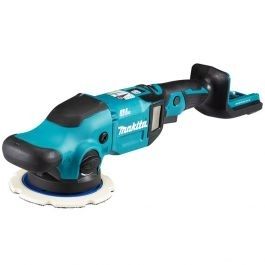Neben den beiden kabelgebundenen Makita Poliermaschinen
PO5000C und 9237CB soll es nun endlich auch eine Makita Akku Poliermaschine geben.
Doch zu früh gefreut.
Bis jetzt ist die Maschine in Deutschland noch nicht erhältlich, lediglich in Australien und Neuseeland kann man das Gerät käuflich erwerben - bis jetzt. Denn bei unserer Recherche sind wir bereits auf eine Deutsche Betriebsanweisung gestoßen. Deshalb gehen wir fest davon aus, dass früher oder später auch die Deutsche Markteinführung erfolgt.
In Australien kostet die Maschine ohne Akku 449 Australische Dollar, ein passender Akku kostet nochmal etwa 139 AUD. Umgerechnet in Euro macht das in etwa 365 Euro - für eine Maschine mit Akku.
Das ist zwar furchtbar viel Geld, aber im Vergleich mit der Akku Poliermaschine von Flex schon nahezu billig.
Deshalb werfen wir jetzt gemeinsam mal auf einen Blick darauf, was wir von der neuen Makita Akku Poliermaschine erwarten dürfen...

Wie wir es schon von der Makita PO5000C und PO6000C kennen wird es diese Maschine auch wieder in zwei Typenbezeichnungen geben.
Dabei unterscheidet die Maschinen in technischer Hinsicht rein gar nichts. Lediglich der Sützteller ist bei der Makita DPO 500 125mm groß, bei der DPO 600 misst er hingegen 150mm.
Angetrieben wird die Maschine von einem bürstenlosen Motor, dadurch gibt es keinen Verschleiß und die Hitzeentwicklung ist besonders gering.
Mit 3,1 kg ohne Akku und 3,5 kg mit Akku ist diese Makita Poliermaschine zwar kein Leichtgewicht aber für Akku Poliermaschinen ist es üblich etwas mehr Gewicht auf die Waage zu bringen.

Genau wie bei der Makita PO5000C kann auch bei der Makita Akku Poliermaschine zwischen Zwangsantrieb und reinem Exzenterbetrieb umgeschaltet werden. So kann man die hohe Abtragsleistung des Zwangsantrieb nutzen und für das Finish einfach umschalten um ein perfektes Ergebnis zu erzielen.
Bei der Akkulaufzeit ist bist jetzt von 25 Minuten die Rede, was realistisch erscheint. Andere Akku Poliermaschinen neigen bei der Akku Laufzeit gerne mal zum Übertreiben.
Weitere Features der DPO 500/600:
- Gummierte Griffläche: Für Idealen Grip und um Beschädigungen durch anstoßen zu verhindern.
- Enbearbeitugsmodus: Im Endbearbeitungsmodus können Sie das Werkzeug betreiben, ohne übermäßige Last auszuüben.
- Konstante Drehzahlregelung: Hält die Drehzahl beim polieren konstant um ein gleichmäßiges Polierergebnis zu erreichen.
- Abnehmbare Lüftungsgitter: Verhindern das Eindringen von Staub und Schmutz in den Motor und sind einfach zu reinigen.
- Sanftanlauf: Verhindert das verspritzen von Politur bei Einschalten der Poliermaschine.
Technische Daten:
- Stütztellergröße: 125 oder 150 mm
- Exzenterhub: 5,5 mm
- Drehzahl: 0-6.800 min-1 im Normalbetrieb 0-5.200 min-1 im Endbearbeitungsmodus
- Lautstärke: 83 dB(A)
- Vibration: 10 m/s²
- Gesamtlänge: 530 mm
Fazit
Bereits die Makita PO5000C hat uns begeistert, dass es dieses Gerät jetzt auch als Akku Poliermaschine geben soll finden wir klasse. Wenn der Preis sich in dem von uns errechneten Bereich bewegt könnte es ein neues Top Modell unter den Akku Poliermaschinen geben.
Verwandte Kaufberatungen und Bestenlisten: